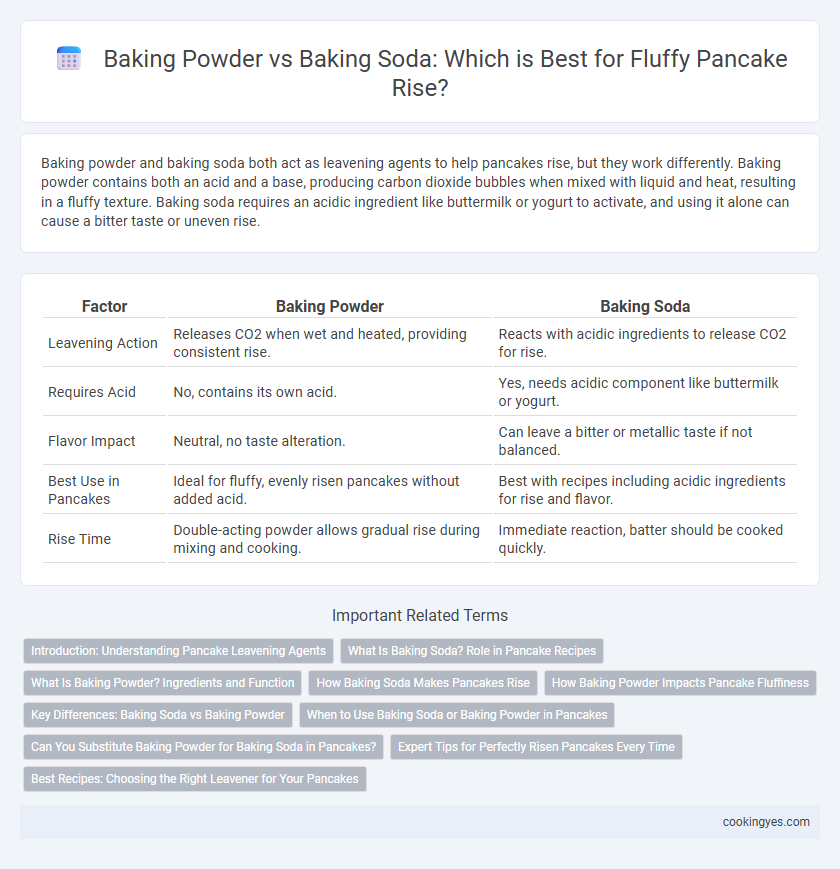Baking powder and baking soda both act as leavening agents to help pancakes rise, but they work differently. Baking powder contains both an acid and a base, producing carbon dioxide bubbles when mixed with liquid and heat, resulting in a fluffy texture. Baking soda requires an acidic ingredient like buttermilk or yogurt to activate, and using it alone can cause a bitter taste or uneven rise.
Table of Comparison
| Factor | Baking Powder | Baking Soda |
|---|---|---|
| Leavening Action | Releases CO2 when wet and heated, providing consistent rise. | Reacts with acidic ingredients to release CO2 for rise. |
| Requires Acid | No, contains its own acid. | Yes, needs acidic component like buttermilk or yogurt. |
| Flavor Impact | Neutral, no taste alteration. | Can leave a bitter or metallic taste if not balanced. |
| Best Use in Pancakes | Ideal for fluffy, evenly risen pancakes without added acid. | Best with recipes including acidic ingredients for rise and flavor. |
| Rise Time | Double-acting powder allows gradual rise during mixing and cooking. | Immediate reaction, batter should be cooked quickly. |
Introduction: Understanding Pancake Leavening Agents
Baking powder contains both an acid and a base, providing a balanced chemical reaction that produces carbon dioxide gas, which helps pancakes rise evenly and achieve a fluffy texture. Baking soda requires an acidic ingredient, such as buttermilk or yogurt, to activate its leavening properties, causing quicker rise and a slightly crisper edge. Choosing the right leavening agent affects pancake volume, texture, and taste, making it essential to understand their chemical differences for optimal results.
What Is Baking Soda? Role in Pancake Recipes
Baking soda, also known as sodium bicarbonate, is a chemical leavening agent that produces carbon dioxide gas when combined with an acid, causing pancake batter to rise and become fluffy. In pancake recipes, baking soda requires an acidic ingredient like buttermilk or yogurt to activate its rising properties and neutralize any metallic taste. Using baking soda correctly ensures light, tender pancakes with an even crumb structure.
What Is Baking Powder? Ingredients and Function
Baking powder is a leavening agent composed of an acid, a base, and a moisture absorber that releases carbon dioxide gas when mixed with liquid and heat, causing pancakes to rise. Typically, its ingredients include sodium bicarbonate (baking soda), cream of tartar (acid), and cornstarch (absorbs moisture). This combination ensures a balanced chemical reaction that produces a light, fluffy texture in pancakes without requiring an external acidic ingredient.
How Baking Soda Makes Pancakes Rise
Baking soda makes pancakes rise by producing carbon dioxide gas when it reacts with acidic ingredients like buttermilk or yogurt, creating bubbles that expand during cooking. This chemical reaction results in a light and fluffy texture, essential for perfect pancakes. Unlike baking powder, which contains both acid and base, baking soda requires an acid to activate its leavening properties.
How Baking Powder Impacts Pancake Fluffiness
Baking powder significantly enhances pancake fluffiness by releasing carbon dioxide gas when mixed with wet ingredients, creating air bubbles that expand during cooking. Its balanced combination of acid and base ensures consistent rise without the need for additional acidic components in the batter, unlike baking soda. This reliable leavening action results in tender, airy pancakes with a light texture and appealing height.
Key Differences: Baking Soda vs Baking Powder
Baking powder contains both an acid and a base, allowing it to produce carbon dioxide bubbles and cause pancakes to rise without additional acidic ingredients, making it ideal for recipes with neutral or non-acidic ingredients. Baking soda requires an acidic component like buttermilk or yogurt to activate its leavening power, creating a quicker rise and a slightly tangier flavor in pancakes. Choosing baking powder results in fluffier, lighter pancakes, whereas baking soda promotes browning and a crispier texture due to its stronger alkalinity.
When to Use Baking Soda or Baking Powder in Pancakes
Baking powder is ideal for pancakes when the recipe lacks acidic ingredients, as it contains both an acid and a base to create consistent rise. Baking soda should be used when pancakes include acidic components like buttermilk or yogurt, activating the soda for immediate leavening. Proper use of baking powder or baking soda ensures fluffy, well-risen pancakes with optimal texture.
Can You Substitute Baking Powder for Baking Soda in Pancakes?
Baking powder contains both an acid and a base, allowing it to create the necessary carbon dioxide for pancake rise without additional acidic ingredients, making it a suitable substitute for baking soda in pancake recipes. When using baking powder instead of baking soda, increase the amount by about three times since baking powder is less concentrated. This substitution results in slightly lighter pancakes but may affect the flavor due to the added acidic components in baking powder.
Expert Tips for Perfectly Risen Pancakes Every Time
Baking powder is a balanced leavening agent that combines an acid and a base, producing carbon dioxide bubbles to create light, fluffy pancakes without requiring acidic ingredients. Baking soda requires an acidic component, such as buttermilk or yogurt, to activate its rising power and prevent a metallic taste. Experts recommend using baking powder for a predictable rise and fluffy texture, but when incorporating acidic ingredients, baking soda can enhance browning and tenderness for perfectly risen pancakes every time.
Best Recipes: Choosing the Right Leavener for Your Pancakes
Baking powder is a balanced leavener containing both acid and base, making it ideal for pancakes that require immediate rise and fluffy texture, while baking soda needs an acidic ingredient like buttermilk to activate and produce lift. Using baking powder in pancake recipes ensures consistent rise and tender crumb, whereas baking soda offers a stronger rise with a slight tang when paired with dairy or citrus. For best pancake results, select baking powder for straightforward recipes and baking soda when incorporating acidic components for optimal fluffiness and flavor.
Baking powder vs baking soda for pancake rise Infographic

 cookingyes.com
cookingyes.com